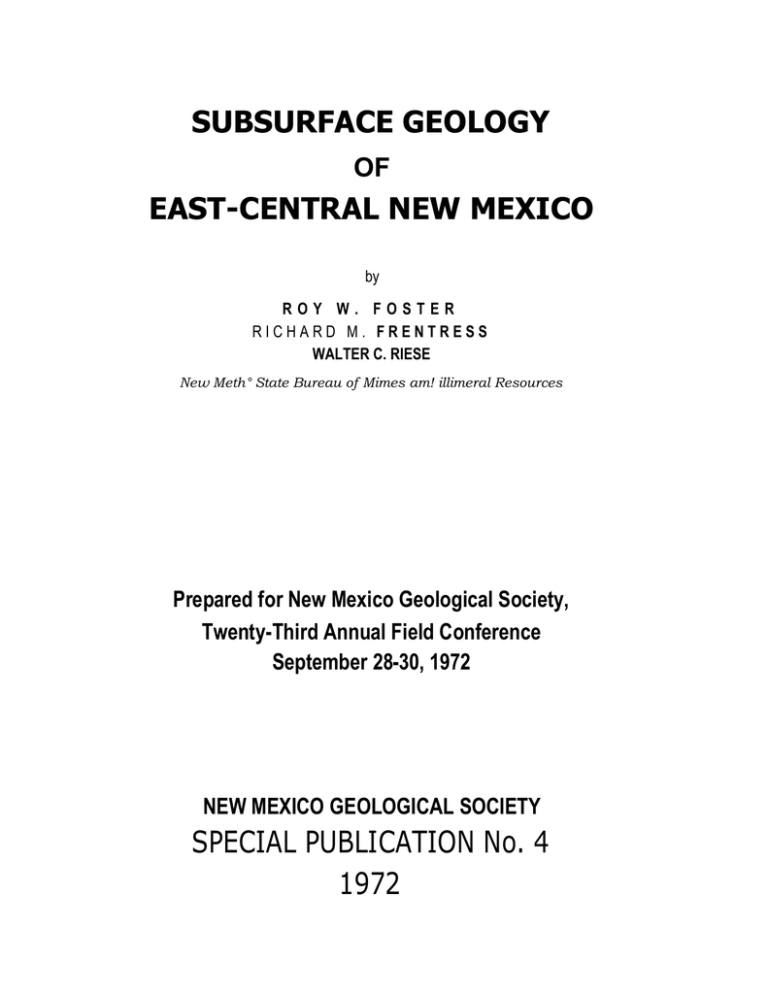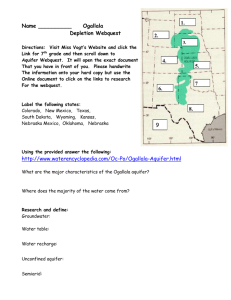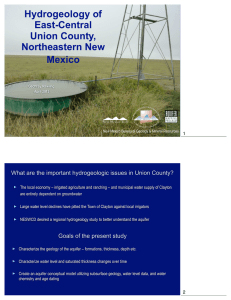SUBSURFACE GEOLOGY EAST-CENTRAL NEW MEXICO OF
advertisement

SUBSURFACE GEOLOGY OF EAST-CENTRAL NEW MEXICO by ROY W. FOSTER RICHARD M. FRENTRESS WALTER C. RIESE New Meth° State Bureau of Mimes am! illimeral Resources Prepared for New Mexico Geological Society, Twenty-Third Annual Field Conference September 28-30, 1972 NEW MEXICO GEOLOGICAL SOCIETY SPECIAL PUBLICATION No. 4 1972 TABLE OF CONTENTS FOREWORD …………………………………………………………………………………………………………………………………………... 1 INTRODUCTION ............................................................................................................................................................................................ 2 CENOZOIC ROCKS ....................................................................................................................................................................................... 2 Ogallala Formation ...................................................................................................................................................................................... 2 Igneous Rocks ............................................................................................................................................................................................. 3 MESOZOIC ROCKS ....................................................................................................................................................................................... 3 CRETACEOUS SYSTEM ............................................................................................................................................................................... 3 Niobrara Formation ...................................................................................................................................................................................... 3 Carlile Shale………………………………………………………………………………………………………………………………………… 3 Greenhorn Limestone .................................................................................................................................................................................. 4 Graneros Shale ............................................................................................................................................................................................ 4 Dakota Sandstone—Purgatoire Formation ................................................................................................................................................ 4 JURASSIC SYSTEM ...................................................................................................................................................................................... 5 Morrison Formation ...................................................................................................................................................................................... 6 Bell Ranch—Wanakah Formations ............................................................................................................................................................. 6 Todilto Limestone ......................................................................................................................................................................................... 6 Exeter Sandstone (Entrada) ........................................................................................................................................................................ 6 TRIASSIC SYSTEM ....................................................................................................................................................................................... 7 Redonda Formation ..................................................................................................................................................................................... 8 Chinle Formation………………………………………………………………………………………………………………………………….. 8 Santa Rosa Sandstone ................................................................................................................................................................................ 8 PALEOZOIC ROCKS ..................................................................................................................................................................................... 9 PERMIAN SYSTEM ........................................................................................................................................................................................ 9 Artesia Group—Bernal Formation .............................................................................................................................................................. 9 San Andres Limestone—Glorieta Sandstone ............................................................................................................................................ 9 Yeso Formation ................................................................................................................................................................... ……………… 11 Sangre de Cristo—Abo Formations ......................................................................................................................................................... 13 PENNSYLVANIAN SYSTEM ...................................................................................................................................................................... 13 MISSISSIPPIAN SYSTEM .......................................................................................................................................................................... 16 ORDOVICIAN SYSTEM .............................................................................................................................................................................. 17 PRECAMBRIAN ROCKS ............................................................................................................................................................................ 17 MAJOR STRUCTURAL FEATURES .......................................................................................................................................................... 17 REFERENCES ............................................................................................................................................................................................. 20 FOREWORD This paper was prepared at the request of Editors V. C. Kelley and F. D. Trauger to appear in the Guidebook of the New Mexico Geological Society's Twenty-Third Field Conference. Instead, it appears as the Society's " Special Publication Number Four" to accompany the Guidebook. An explanation is in order as this is a precedent-setting procedure. The first step when a guidebook for a particular area is planned is to contact those people who know the region, its geology, and the associated problems, and to obtain from them a pledge to contribute their time, energy and special knowledge in the form of p a p e rs t o b e p u b l i s h e d i n t h e g u i d e b o o k . T h e u n c e rt a i n t i e s a t t e n d a n t u p o n t h i s i n i t i a l e f f o rt h a ve ra m i f i c a t i o n s o f t e n n e ve r considered by the contributor, or those who casually leaf through a guidebook, wondering, perhaps, why in heaven's name the editors did this, or that. A f i e l d c o n f e re n c e g u i d e b o o k , u n l i k e a l m o s t a n y o t h e r b o o k p u b l i c a t i o n , m u s t b e re a d y f o r d i s t ri b u t i o n o n a g i ve n d a y. A hard-cover guidebook poses special problems, and therein lies the reason for "Special Publication Number Four." A hard cover must be ordered 10 weeks in advance of printing and binding deadlines. That means the size of the guidebook —the num ber of pages to be bound in — m ust be determ ined at the tim e the covers are ordered. On the basis of the response from potential contributors, and the page estimate as specified, a cover to accommodate 200 pages was ordered. The papers began coming in, and coming, and coming. Authors from whom the editors had no initial response sent papers, and at least 50 percent of the papers exceeded the lengths specified. The deluge resulted in estimates by the printer, based on galley proof, of 257 pages —a number impossible to accommodate. A thinner paper was selected and it was found that 238 pages could be bound. The editors then had a choice—eliminate three to five short papers or one long one. One contribution, a paper of 21 pages, prepared to treat one phase of the geology of the conference area, was determined to be capable of standing alone, and by removing it from the guidebook, all other papers could be accommodated. But this paper was considered essential to com plete the them e and purpose of the conference guid ebook. The Publications Com m ittee, with the approval of the Executive Committee of the Society, agreed the paper should be published as a supplement to the Guidebook, and at the same time be made available as a separate publication for those with a special need for its particular contribution. The paper, Subsurface Geology of East-Central New Mexico, by Roy W . Foster, Richard M. Frentress, and W alter C. Riese is here presented exactly as prepared for the Guidebook. The Publications Committee Fred Trauger, Chairman Frank Kottlowski Robert Kelley SUBSURFACE GEOLOGY OF EAST-CENTRAL NEW MEXICO b y ROY W. FOSTER RICHARD M. FRENTRESS W ALTER C. RIESE New Mexico State Bureau of Mines and Mineral Resources The development of caliche has been extensively studied. Price, Elias, and Frye (1946) noted that algal reef bodies, both oval and tabular forms, occur in the limestone caprock of the Ogallala Formation. These bodies generally occur, along with large concretions, in the topmost part of the limestone. Microscopic studies of caliche from Union County revealed the presence of algal masses representing molds of colonies of the low thread-like type. INTRODUCTION The following report is a summary of the stratigraphy of a part of eastern New Mexico. Although the bibliography for this area is fairly extensive very little of it deals with specifics that might be of direct interest to the petroleum geologist, and even less with the subsurface stratigraphy of the area. This is somewhat surprising considering the obvious petrolem potential. Because of this lack of information it seemed that the best approach for a guidebook article would be a summary of the entire section, pointing out some of the problems, plus isopach data heretofore not published. Although it would be of value to list individual wells with specific data regarding tops, reported shows, etc., much of this needs additional work to go beyond what is already available through various service companies. More detailed studies of the area are currently underway and this information will be included in later reports. Bretz and Horberg (1949) considered the finely banded caliche to be inorganic in origin and concluded that the caliche is concentrated in the B-zone of a soil profile by evaporation of soil water. The caliche formed under conditions of alter nating saturation and desiccation in a relatively dry climate. Solution occurred as soil waters moved downward during rainy periods and precipitation of the carbonate took place with capillary rise of saturated alkaline solutions as the soil zone dried. The conglomerate of the Ogallala Formation was composed largely of limestone clasts, explaining the nodular, pisolitic nature of some of the material. More resistant clasts, such as quartzite, are left behind in the caliche. The data on which the maps arc based come from scout information, geophysical logs, and strip logs. However, enough samples from wells in the area have been examined to establish with confidence the basic sedimentary framework. Ogallala Formation CENOZOIC ROCKS The Ogallala Formation underlies large areas in east-central New Mexico, particularly in the vicinity of Roy, north of Logan, and on the Llano Estacado south of Tucumcari. Numerous outlying remnants of the once connected Llano Estacado and Las Vegas Plateau surfaces arc capped by this formation. No Ogallala is shown west of the Pecos River on the State geological map by Dane and Bachman (1965), but much of this area is underlain by gravels, sands, and clays correlative with this interval. In Torrance County Smith (1957) considered some high-level sands, silts, and gravels equivalent to the Ogallala. These sediments overlie Precam brian near Pedernal Peak, the Yeso Formation north of Negra, the San Andres Limestone along the eastern Torrance County line, and the Dockum Group in the northeast corner of the county. Darton (1928) mapped Ogallala near Pedernal Peak, and Bretz and Horberg (1949) found deposits along U.S. 60. The gravels consist largely of quartzite, some of cobble size, and probably are derived from the quartzites of the Pedernal Mountains. According to Bretz and Horberg the Ogallala of eastern New Mexico ranges from a few tens of feet over pre -Ogallala hills and ridges to from 400 to 550 feet over buried valleys. They believed that the present southeasterly slope of 10 to 15 feet per mile is the original depositional slope. Conglomerates in the Ogallala contain clasts of limestone, quartzite, vein quartz, jasper, granite, chert, porphyry, and lava. Siliceous pebbles are far more abundant than the igneous, and limestone pebbles seem to dominate based on their pebble counts. Cenozoic rocks include alluvial and dune deposits, caliche, sand and gravel of Tertiary age, and intrusive and extrusive igneous rocks. Extensive active dunes are present north of Logan and between Clovis and Portales. A veneer of alluvium covers much of the area and often is difficult to separate from Triassic sediments where derived from these rocks. Alluvial deposits consist of sand, silt, clay, and gravel, and almost everywhere contain soft grains to small nodules of impure caliche. These unconsolidated sediments vary considerably in thickness from zero to as much as 600 feet in the Tucumcari area (Trauger and Bushman, 1964). Deposits of caliche are widespread and range from the indurated caprock of the Llano Estacado, Las Vegas Plateau, and various buttes and mesas to the more recent material found in the alluvial deposits. The hard, banded, pisolitic caliche of the caprock has been considered by many geologists as the youngest unit of the Ogallala Formation. Baldwin and Muehlberger (1959) suggested that the caliche should be considered a separate lithologic unit because it does not everywhere overlie the Ogallala but may be developed on basalt flows or pre-Ogallala sediments. It is not known just when the caliche formed but it post-dates the post-Ogallala surface and predates all but the initial stage of dissection of this surface. Thus the time of formation of the caliche must be latest Pliocene or earliest Pleistocene. 2






